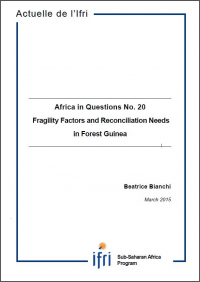Gateway to Think Tanks
| 来源类型 | Publications - Editorials - L'Afrique en questions |
| 规范类型 | 评论 |
| Fragility Factors and Reconciliation Needs in Forest Guinea L’Afrique en questions, No. 20, March 2015 | |
| Béatrice BIANCHI | |
| 发表日期 | 2015-03-31 |
| 出处 | L'Afrique en questions |
| 出版年 | 2015 |
| 概述 | In December 2013 the first Ebola cases surfaced in Guéckedou district, near the Liberian and Sierra Leon borders in the Forest Region of Guinea. The outbreak quickly spread from Forest Guinea to the rest of the country and, through the borders, to neighbouring countries. It took three... |
| 摘要 |
Fragility Factors and Reconciliation Needs in Forest Guinea L’Afrique en questions, No. 20, March 2015
In December 2013 the first Ebola cases surfaced in Guéckedou district, near the Liberian and Sierra Leon borders in the Forest Region of Guinea. The outbreak quickly spread from Forest Guinea to the rest of the country and, through the borders, to neighbouring countries. It took three months to identify the Ebola virus as the causative agent of the burgeoning epidemic, longer for the Guinean government to understand the importance of treating the outbreak as a national emergency, and even more time for everyone involved to appreciate the great social toll of Ebola.  As the epicentre of the epidemic, Forest Guinea felt the brunt of the disease and of the sudden intervention of outsiders into their communities. For a region where the State had previously been all but absent and even mistrusted, there was great resistance towards health care workers and outbreak control teams. Violence shortly followed. The most serious episode occurred in mid-September 2014 in Womey, an ethnic forestier village located in an area of major international mining interests near the region’s capital of Nzerekoré. Villagers who suspected a government-led health education delegation of in fact spreading the virus killed eight members of the team. The government reacted by militarising the town. The scared inhabitants fled into the surrounding forest for several weeks as fear of a government reprisal and rumours of former ULIMO and Dozos militias among the army circulated. Looting and lawlessness ensued. It was not until November of that year that residents could return to their village. The cultural, social and political environments in Forest Guinea have developed a complex matrix of structures that renders the region both fragile and unstable. The Ebola outbreak, and in particular the Womey episode, should be taken as a paradigm that reflects the latent forces affecting the region. This is characterised by a combination of intercommunal tensions, disenfranchisement from power, and perceptions of insecurity. The aim of this short paper is to provide a socio-political framework through which the structural violence of the Forest Guinea region can be understood.
Fragility Factors and Reconciliation Needs in Forest Guinea
|
| 关键词 | Ebola ethnicity social protest Guinea West Africa |
| URL | https://www.ifri.org/en/publications/editoriaux/lafrique-questions/fragility-factors-and-reconciliation-needs-forest-guinea |
| 来源智库 | French Institute of International Relations (France) |
| 资源类型 | 智库出版物 |
| 条目标识符 | http://119.78.100.153/handle/2XGU8XDN/415959 |
| 推荐引用方式 GB/T 7714 | Béatrice BIANCHI. Fragility Factors and Reconciliation Needs in Forest Guinea L’Afrique en questions, No. 20, March 2015. 2015. |
| 条目包含的文件 | ||||||
| 文件名称/大小 | 资源类型 | 版本类型 | 开放类型 | 使用许可 | ||
| capture_forest_guine(29KB) | 智库出版物 | 限制开放 | CC BY-NC-SA |  浏览 | ||
| actuelle-guinee-b.bi(610KB) | 智库出版物 | 限制开放 | CC BY-NC-SA | 浏览 | ||
除非特别说明,本系统中所有内容都受版权保护,并保留所有权利。